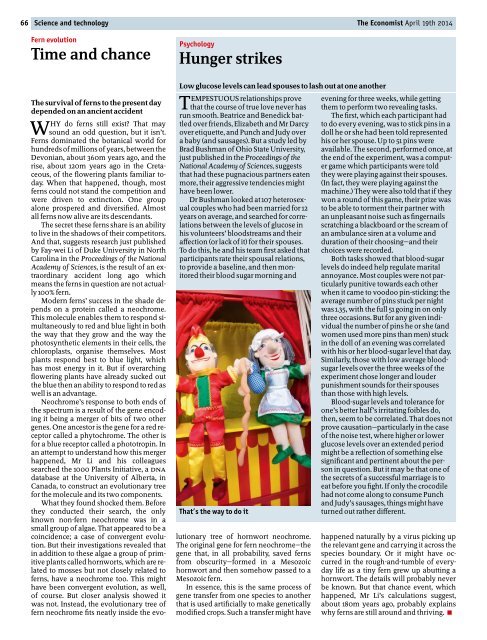The Economist - 19_25 April 2014
The Economist - 19_25 April 2014
The Economist - 19_25 April 2014
- No tags were found...
You also want an ePaper? Increase the reach of your titles
YUMPU automatically turns print PDFs into web optimized ePapers that Google loves.
66 Science and technology <strong>The</strong> <strong>Economist</strong> <strong>April</strong> <strong>19</strong>th <strong>2014</strong>Fern evolutionTime and chancePsychologyHunger strikesLow glucose levels can lead spouses to lash out at one anotherTEMPESTUOUS relationships prove evening for three weeks, while gettingthat the course oftrue love never has them to perform two revealing tasks.run smooth. Beatrice and Benedickbattledover friends, Elizabeth and Mr Darcy to do every evening, was to stickpins in a<strong>The</strong> first, which each participant hadover etiquette, and Punch and Judy over doll he or she had been told representeda baby (and sausages). But a study led by his or her spouse. Up to 51pins wereBrad Bushman ofOhio State University, available. <strong>The</strong> second, performed once, atjust published in the Proceedings of the the end ofthe experiment, was a computergame which participants were toldNational Academy of Sciences, suggeststhat had these pugnacious partners eaten they were playing against their spouses.more, their aggressive tendencies might (In fact, they were playing against thehave been lower.machine.) <strong>The</strong>y were also told that if theyDr Bushman looked at107 heterosexualcouples who had been married for 12 to be able to torment their partner withwon a round ofthis game, their prize wasyears on average, and searched for correlationsbetween the levels ofglucose in scratching a blackboard or the scream ofan unpleasant noise such as fingernailshis volunteers’ bloodstreams and their an ambulance siren at a volume andaffection (or lackofit) for their spouses. duration oftheir choosing—and theirTo do this, he and his team first asked that choices were recorded.participants rate their spousal relations, Both tasks showed that blood-sugarto provide a baseline, and then monitoredtheir blood sugar morning and annoyance. Most couples were not par-levels do indeed help regulate maritalticularly punitive towards each otherwhen it came to voodoo pin-sticking: theaverage number ofpins stuckper nightwas1.35, with the full 51going in on onlythree occasions. But for any given individualthe number ofpins he or she (andwomen used more pins than men) stuckin the doll ofan evening was correlatedwith his or her blood-sugar level that day.Similarly, those with low average bloodsugarlevels over the three weeks of theexperiment chose longer and louderpunishment sounds for their spousesthan those with high levels.Blood-sugar levels and tolerance forone’s better half’s irritating foibles do,then, seem to be correlated. That does notprove causation—particularly in the caseofthe noise test, where higher or lowerglucose levels over an extended periodmight be a reflection ofsomething elsesignificant and pertinent about the personin question. But it may be that one ofthe secrets ofa successful marriage is toeat before you fight. Ifonly the crocodilehad not come along to consume Punchand Judy’s sausages, things might haveThat’s the way to do itturned out rather different.<strong>The</strong> survival offerns to the present daydepended on an ancient accidentWHY do ferns still exist? That maysound an odd question, but it isn’t.Ferns dominated the botanical world forhundreds ofmillions ofyears, between theDevonian, about 360m years ago, and therise, about 120m years ago in the Cretaceous,of the flowering plants familiar today.When that happened, though, mostferns could not stand the competition andwere driven to extinction. One groupalone prospered and diversified. Almostall ferns now alive are its descendants.<strong>The</strong> secret these ferns share is an abilityto live in the shadows of their competitors.And that, suggests research just publishedby Fay-wei Li of Duke University in NorthCarolina in the Proceedings of the NationalAcademy of Sciences, is the result of an extraordinaryaccident long ago whichmeans the ferns in question are not actually100%fern.Modern ferns’ success in the shade dependson a protein called a neochrome.This molecule enables them to respond simultaneouslyto red and blue light in boththe way that they grow and the way thephotosynthetic elements in their cells, thechloroplasts, organise themselves. Mostplants respond best to blue light, whichhas most energy in it. But if overarchingflowering plants have already sucked outthe blue then an ability to respond to red aswell is an advantage.Neochrome’s response to both ends ofthe spectrum is a result of the gene encodingit being a merger of bits of two othergenes. One ancestor is the gene for a red receptorcalled a phytochrome. <strong>The</strong> other isfor a blue receptor called a phototropin. Inan attempt to understand how this mergerhappened, Mr Li and his colleaguessearched the 1000 Plants Initiative, a DNAdatabase at the University of Alberta, inCanada, to construct an evolutionary treefor the molecule and its two components.What they found shocked them. Beforethey conducted their search, the onlyknown non-fern neochrome was in asmall group ofalgae. That appeared to be acoincidence; a case of convergent evolution.But their investigations revealed thatin addition to these algae a group of primitiveplants called hornworts, which are relatedto mosses but not closely related toferns, have a neochrome too. This mighthave been convergent evolution, as well,of course. But closer analysis showed itwas not. Instead, the evolutionary tree offern neochrome fits neatly inside the evolutionarytree of hornwort neochrome.<strong>The</strong> original gene for fern neochrome—thegene that, in all probability, saved fernsfrom obscurity—formed in a Mesozoichornwort and then somehow passed to aMesozoic fern.In essence, this is the same process ofgene transfer from one species to anotherthat is used artificially to make geneticallymodified crops. Such a transfer might havehappened naturally by a virus picking upthe relevant gene and carrying it across thespecies boundary. Or it might have occurredin the rough-and-tumble of everydaylife as a tiny fern grew up abutting ahornwort. <strong>The</strong> details will probably neverbe known. But that chance event, whichhappened, Mr Li’s calculations suggest,about 180m years ago, probably explainswhy ferns are still around and thriving. 7


